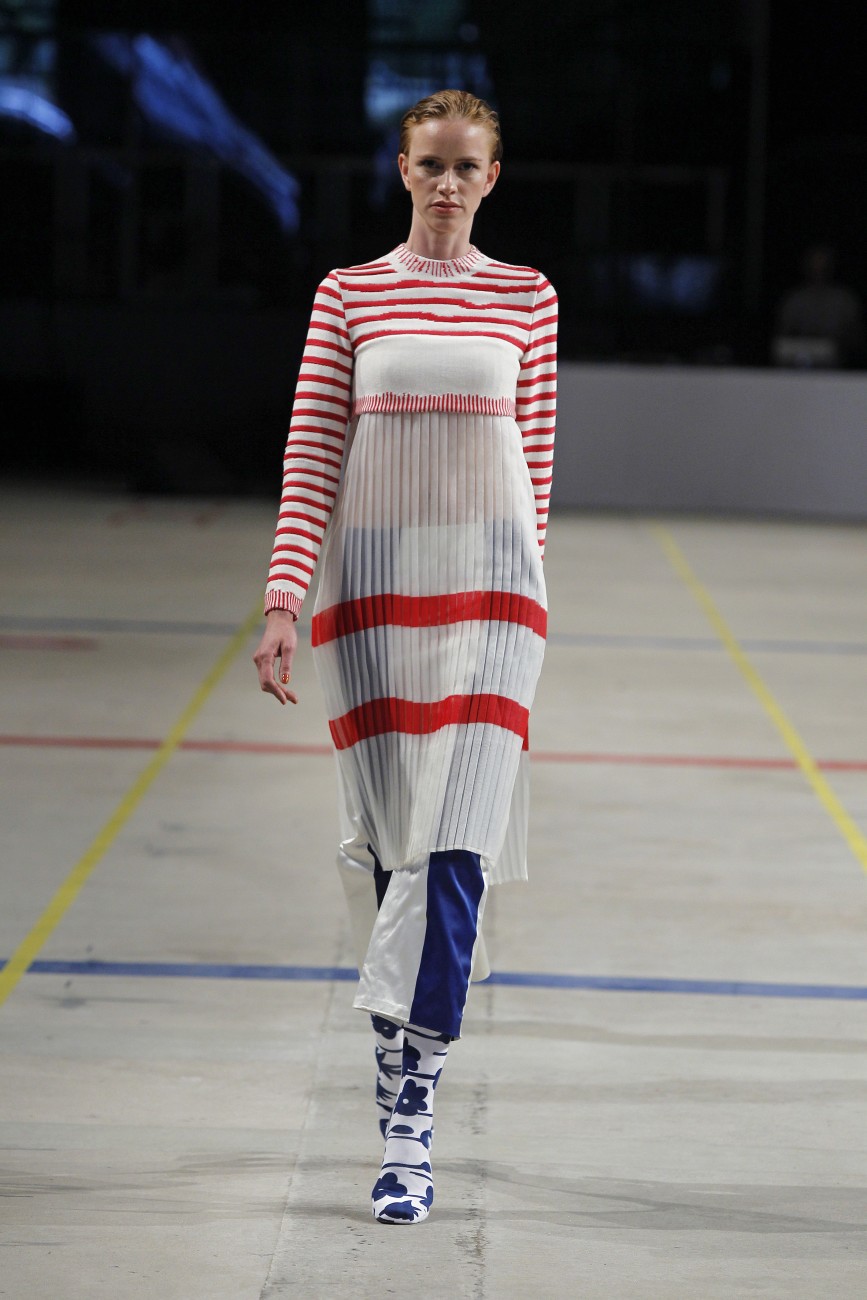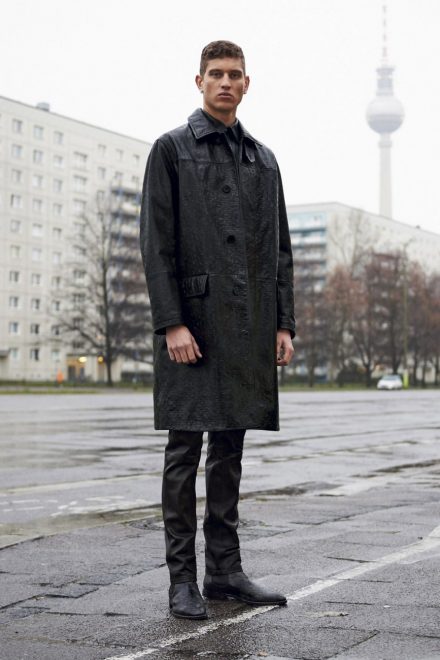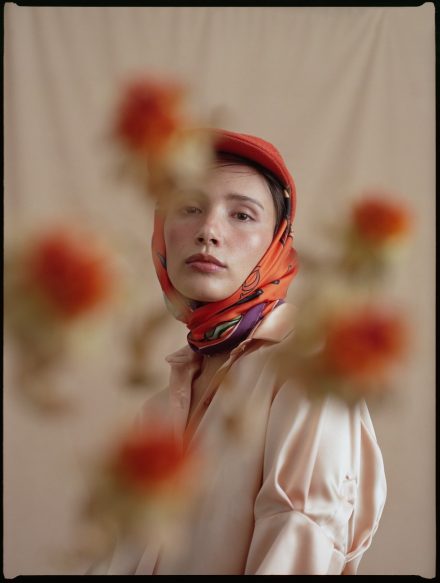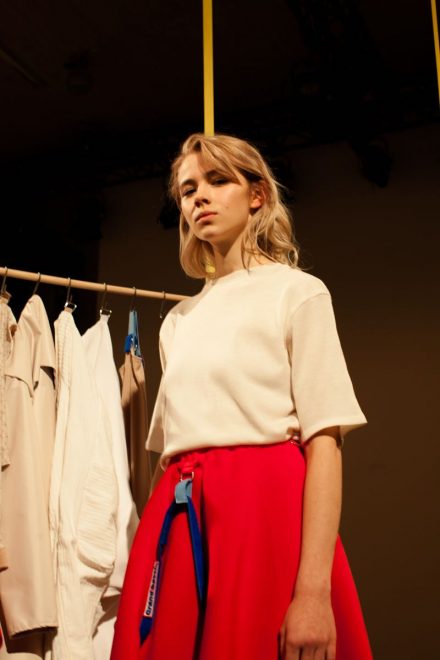
It’s incredibly refreshing to be a part of fashion being taken back to its personal roots. Sitting in the Erika Hess Eisstadion on Friday evening there was the deliciously nostalgic smell of ancient sporting events in the air. I sat next to young restless children and grannies with definitive and frank interpretations of the looks coming down the runway, there was laughter, furrowed eyebrows, hanging jaws, shakes of the head and then, when a recognizable aesthetic appeared there were proud smiles, slightly tightened so as to not let a squeal escape and fists clenched with anticipation. It’s easy to tell who in the audience has a daughter or son or cousin in the show because they are glowing with the kind of excitement that only appears when one feels genuinely proud of and connected to a person they love. Scattered among these beaming faces are editors, stylists, journalists, interns, PR reps, creative directors and so on, and they look significantly less taken by the whole thing because they have a job to do. Upon seeing these faces I remembered that I was not in fact, at a dance recital. I was here to witness the work and vision of 16 serious young designers come to fruition. I too had a job to do.
The buzz that is Fashion Week makes it easy to forget that designers wear many hats. They are artists, craftsmen and women and businesspeople. The “delicate genius” is not an actual thing and that visage is shattered when we are reminded of the work and progress designers must make in order to produce a collection. When you work behind the scenes in fashion you also know just how many people contribute to this progression.
When I arrived at the ice rink, I was ushered backstage where twenty-something young designers rushed around bursting garment racks and distressed looking models. If you think backstage is madness when one designer is involved, imagine what happens when there are 49 designers showing looks (individually or collectively as part of a team or class presentation). It was the most joyous backstage I visited this fashion week despite the chaos. A door in the large dressing room led to an outside space where the designers chatted, hung on one another only as close friends do and sat in circles on the ground smoking hand rolled cigarettes (of course).
I met Muyao Zhang, a graduate of the Bachelor program backstage and was given an overview of her 37 piece collection called “Delete”. Zhang is petit and has an enviable carpet of long dark hair. “It’s dedicated to the one you love whom you don’t know,” Zhang tells me and I casually jot this down without much thought. It was Friday night, and I felt a bit jaded because you can only hear about how universal a collection is so many times… Right? “Do you want to know what that means?” she asked me. Oh. I probably should, yes. “It’s dedicated to my brother, who I’ve never met. My mother abandoned him and so this collection is for him. Because I wonder who he is and I don’t know who he is. I wonder what he looks like, and if I would know him if I saw him.”

Zhang grew up in Beijing and says her mother was forced to give the boy up because of an unsafe family situation. Her mother was 37 years old at the time, the age her brother should be right now. “What a person wears tells you who they are. It contains their story. I want to make you aware of the information and the lack of information in our clothing.” She says. So Zhang’s pieces are interpretations of the clothing her brother might wear. She has “deleted” a significant detail from each pattern to suggest the lack of information her brothers clothing might contain like a pocket or an expected seam. The silhouettes themselves are taken from traditional Chinese men’s robes and some textiles are printed with distorted and blurred photographs of Zhang’s mother. I ask her if it was difficult to make a collection this personal and if her work is always this personal “No, I had never done it before. No, no it wasn’t hard. Everything is this way.” I took that to mean that work is always personal.

Zhang’s collection and words embodied an ethos that I witnessed a lot of at the show: a close personal connection to the intention and construction of each garment. Kai Gerhardt, another graduate of the Bachelor program and a nominee of the German Fashion Industry Fund (he joins Ulf Michael Brauner), showed a menswear collection comprised of a number of knits that he made himself using a hand loom. “It took me three weeks total, just for the knits” he said, but according to Gerhardt that tactile process is important. “I really like to use my hands and to have that physical connection to my work.”

There were a number of standouts on Friday and in step with the trends we saw earlier this week, there was a lot of men’s wear and a lot of normcore going on (think fanny packs, Teva’s and backpacks). Sean Neubauer, a Bachelor grad showed seven looks that reinterpret a certain Carhartt/Americana sensibility combined with a minimalist mountain-man spirit. Maren Langer, a diploma graduate created a dreamy installation of models on a bed in modish white dresses and water-bed inspired shoes. Sarah Effenberger presented a beautifully constructed and cohesive menswear collection with highly experimental and sculptural jackets (yes, there were man-skirts involved). A personal favorite was Bettina Mileta who presented 10 solid wintery looks. There were wooly high waist flared trousers with considered pleats, cropped sweaters and tight leotard like tops, perfectly fitted to the female form. I’ve also been dreaming about Gesine Forsterling’s knit bralettes, and Ayscha Zarina Omar’s playful maxi dresses, which are a bit like if your crazy great-Aunt Mary’s muumuu mated with a Miu Miu. Magdalena Samuel, a diploma grad also showed a covetable and cohesive collection of beautifully draped dresses, pants and long jackets. Her choice in textiles was particularly intriguing and there were also these super cool socks that covered the shoes of the models, which I thought was a pretty brilliant detail.
The show reminded me of what remains when you strip “fashion” of all of its fuss and gloss… Marc Jacobs said it best when he said that at the end of the day, designers “just make stuff”. Recognizing the “stuff” that people make and the life forces behind it is noteworthy in my book. And all that fussiness makes it sort of fun to watch.














